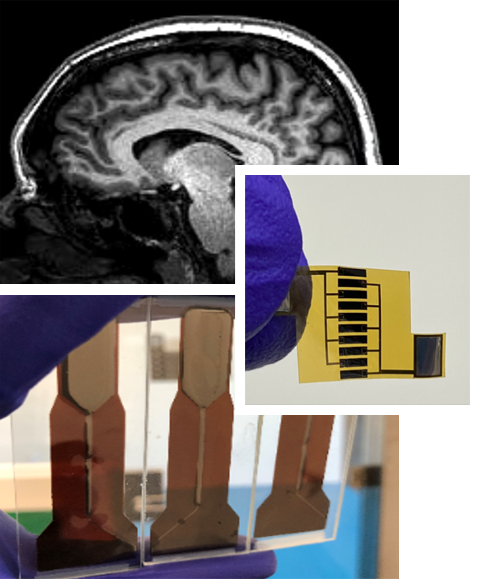Technology
Grapheton’s core technology lies in its carbon-based microfabrication and integration technology which allows it to build probes that have excellent electrical characteristics, high electrochemical stability, purely capacitive charge injection (no irreversible reactions and byproducts), fast surface electrochemical kinetics, and biocompatibility, qualities critical for chronically implanted devices that produce minimal tissue damage.
The same technology that allows Grapheton to build these microelectrodes has also been applied to fabrication of micro supercapacitors with remarkable charge storage capacity. These supercapacitors that are mounted on flexible polymer substrates can be integrated with bioelectronic devices or other wearable & implantable devices which require an on-chip energy source.
With Grapheton’s technology, carbon-based implantable and wearable devices, sensors, energy storage devices and prosthetics are now a reality.

PUBLICATIONS ON CORE GRAPHETON TECHNOLOGY
- Vahidi, N., Rudraraju, S., Castagnola, E., Cea, C., Nimbalkar, S., Hanna, R., Arvizu, R., Dayeh, S.A., Gentner, T.Q., Kassegne, S., “Epi-intra Neural Probes with Glassy Carbon Microelectrodes Help Elucidate Neural Coding and Stimulus Encoding in 3D Volume of Tissue”, Journal of Neural Engineering, Volume 17, Number 4, 2020.
- Nimbalkar, S., Fuhrer, E., Silva, P., Nguyen, T., Sereno, M., and Kassegne, S., “Glassy Carbon Microelectrodes Minimize Induced Voltages, Mechanical Vibrations, and Artifacts in Magnetic Resonance Imaging,” Nature Microsystems & Nanoengineering 5 (1), 1-11, 2019.
- Burks, R., Walker, Z., O’Neill, C., Kassegne, S., “Microfabrication of Multi-layer Glassy Carbon Microstructures through Dye-doped Negative Photoresists,” Journal of Micromechanics and Microengineering 29 (12), 125012, 2019.
- Nimbalkar, S., Castagnola, E., Balasubramani, A., Scarpellini, A., Samejima, S., Khorasani, A., Boissenin, A., Thongpang, S., Moritz, C., and Kassegne, S., “Ultra-Capacitive Carbon Neural Probe Allows Simultaneous Long-Term Electrical Stimulations and High-Resolution Neurotransmitter Detection”, Nature Scientific Reports 8 (1), 6958, 2018.
- Goshi, N., Castagnola, E., Vomero, C Gueli, C Cea, E Zucchini, D Bjanes, Maggiolini, E., Moritz, C., Kassegne, S., Ricci, D., Fadiga, L., “Glassy Carbon MEMS for Novel Origami-styled 3D Integrated Intracortical and Epicortical Neural Probes“, Journal of Micromechanics and Microengineering 28 (6), 065009, 2018.
- Vomero, M., Castagnola, E., Ordonez, JS., Carli, S., Zucchini, E., Maggiolini, E., Gueli, C., Goshi, N., Ciarpella, F., Cea, C., Fadiga, L., Ricci, D., Kassegne, S., Stieglitz, T., “Electrocorticography Arrays: Incorporation of Silicon Carbide and Diamond-Like Carbon as Adhesion Promoters Improves In Vitro and In Vivo Stability of Thin-Film Glassy Carbon,” Advanced Biosystems 2 (1), 1870001, 2018.
- Hirabayashi, M., Logan, K., Deutschman, CP., McDowell, TW., Torres, M., Pullman, D., Kassegne, S., “Investigation of Interface Bonding Mechanisms between Glassy Carbon Microelectrodes and Polyimide Substrate through Fourier Transform Infrared Spectroscopy”, Journal of The Electrochemical Society 165 (8), B3060-B3070, 2018.
- Castagnola, E., Vahidi, N., Nimbalkar, S., Rudraraju, S., Thielk, M., Zucchini, E., Cea, C., Carli, S., Gentner, T., Ricci, D., Fadiga, L., Kassegne, S., “In Vivo Dopamine Detection and Single Unit Recordings Using Intracortical Glassy Carbon Microelectrode Arrays“, MRS Advances, 1-6, 2018.
- Vomero, M., Castagnola, E., Ciarpella, F., Maggiolini, E., Goshi, N., Zucchini, E., Carli, S., Fadiga, L., Kassegne, S., Ricci, D., “Highly Stable Glassy Carbon Interfaces for Long-Term Neural Stimulation and Low-Noise Recording of Brain Activity”, Nature Scientific Reports, Vol. 7, 4033, DOI: 10.1038/srep40332, 2017.
- Castagnola, E., Carli, S., Vomero, S., Scarpellini, A., Prato, M., Goshi, N., Fadiga, L., Kassegne, S., Ricci, D., “Multilayer poly (3, 4-ethylenedioxythiophene)-dexamethasone and poly (3, 4-ethylenedioxythiophene)-polystyrene sulfonate-carbon nanotubes coatings on glassy carbon.”, Biointerphases 12 (3), 031002, 2, 2017.
- Hirabayashi, M., Huynh, NH, Witsell, S., Perez, A., Sandoval, L., Yamada, N., and Kassegne, S., “In-Vitro Real-Time Coupled Electrophysiological and Electrochemical Signals Detection with Glassy Carbon Microelectrodes”, Journal of the Electrochemical Society 164 (5), B3113-B3121, 2017.
- Vomero, M, van Niekerk, P, Kassegne, S., et al, “Novel Pattern Transfer Technique for Mounting Glassy Carbon Microelectrodes on Polymeric Flexible Substrates“, JMM (Journal of Micromechanics and Microengineering), Volume 26, Number 2, 2016.
- Vomero, M., Dryg, I., Maxfield, T., Shain, W., Perlmutter, S., and Kassegne, S., “In-vivo Characterization of Glassy Carbon µElectrodes and Histological Analysis of Brain Tissue after Chronic Implants”, ECS Trans. Volume 72, Issue 1, 91-96, doi: 10.1149/07201.0091, 2016.
- Goshi, N., Vomero, N., Dryg, I., and Kassegne, S., “Modeling and Characterization of Tissue/Electrode Interface in Capacitive µECoG Glassy Carbon Electrodes”, ECS Trans. Volume 72, Issue 1, 83-90, doi: 10.1149/07201.0083, 2016.
- Vomero, Castagnola, E., Maggiolini, E., Ciarpella, F., Rembado, I., Goshi, N., Fadiga, L., Kassegne, S., Ricci, D., “A Direct Comparison of Glassy Carbon and PEDOT-PSS Electrodes for High Charge Injection and Low Impedance Neural Interfaces”, Advances in Science and Technology 102, 68-76, Trans Tech Publications, 2016.
- Kassegne, S., Vomero, M., Gavuglio, R., Hirabayashi, M., Özyilmaz, E., Nguyen, S., Rodriguez, J., Özyilmaz, E., van Niekerk, P., Khosla, A., “Electrical Impedance, Electrochemistry, Mechanical Stiffness, and Hardness Tunability in Glassy Carbon MEMS mECoG Electrodes”, J. of Microelectronics Engineering, Volume 133, Pages 36–44, 2015.
